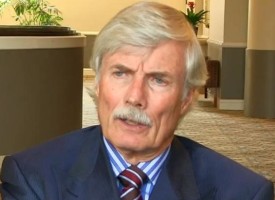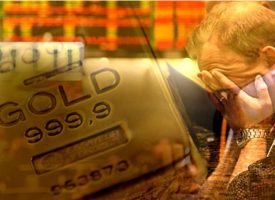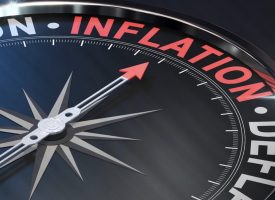As we get ready to kickoff trading in the second month of 2022, this will create utter chaos.
January 30 (King World News) – Dr. Stephen Leeb: An old Wall Street aphorism says the Fed writes the market letter. I.e., the best guide to how the market will behave is to look at what the Fed does or indicates it will do. But what if the Fed’s message is so confused that it’s impossible to read?
That’s the case after the Fed’s most recent meeting, which was more befuddling than any I’ve ever seen. It left about half of market analysts concluding the Fed was too dovish in not raising rates despite inflation at a 40-year high. The other half, focusing on Chairman Powell’s press conference remarks, saw the Fed as unexpectedly hawkish.
The fact that the Fed’s comments and actions (or lack thereof) seemingly were more a Rorschach test than a clear statement of intentions is, ironically, likely another important punctuation mark in a transitioning world economy. The Fed’s murkiness in itself does contain a clear message for investors: Protecting wealth is far more important than seeking more.
It Points To Gold
That, of course, points to gold. But if I am half right about where gold ultimately is headed, you will be able to have your cake – protecting your wealth – and grow it, too, as gold explodes into a massive bull market.
Since the early 1970s, the U.S. has faced numerous economic and market crises, including the surging inflation in the 1970s, the market crash of 1987, Mideastern wars, the tech bubble and collapse, the shock of 9/11, the 2008 housing crash and subsequent financial crisis, and most recently the economic blow from the pandemic. In these and other cases, the abiding belief of policymakers has always been that the solution lay with money – generally in increasing the amount of money, with the exception of Paul Volcker’s harsh money-reducing policies, which quelled inflation at the cost of double-digit unemployment. Either way, though, money was seen as the answer…
New interview from legend Doug Casey discussing gold, silver and
global chaos! To listen click here or on the image below.

But the Fed’s recent befuddlement confirms something I first began writing about more than two decades ago, in my 1999 book Defying the Market. My message was that we faced problems – in the form of forthcoming resource scarcities – that couldn’t be solved by focusing research on the short-term returns produced by the information technologies that were so worshiped. I argued we needed to focus not on IT but on developing technologies dedicated to sustainability.
It didn’t happen. Instead, in the last 20 years the apotheosis of IT and fintech – which combine in a single word, money – has continued, with money seen as the answer to any problem that comes our way. I’ve pointed before, in these interviews and in my latest book, China’s Rise and the New Age of Gold, to how this belief became embedded starting in the 1970s after we abandoned the gold standard, leaving us free, because of the dollar’s continuing role as the world’s reserve currency, to print as much money as we wanted. That made it easy to focus on short-term gratification rather than on long-term goals and was the start of a long-term decline in U.S. life. And it has led to the impossible dilemma now facing the Fed.
The Fed needs to curb inflation without cratering the economy. This isn’t Paul Volcker’s economy. Double-digit unemployment today, terrible back then, would be catastrophic today both financially and socially. Our current debt levels, already off the charts, would take another exponential leap, while societal unrest, bad enough today, would become truly frightening.
Two of the primary causes of today’s rising inflation are high energy (and other commodity) prices and a shortage of skilled labor. Neither is amenable to short-term monetary solutions. Let’s look at the energy component first. I think historians will come to see that at least part of today’s energy problems stems from our misguided belief that money would let us buy energy independence, and do so quickly. And yes, I’m referring to fracking.
In the wake of the oil price explosion in 2008, many saw fracking as the answer to our dreams of energy independence. But while some frackers earned, and continue to earn, meaningful economic returns, there was simply no economic basis for ramping up fracking production from close to zero at the end of 2009 to about 8 million barrels a day in early 2020. In the three and a half years from late 2016 to its peak, fracking production was increasing by more than 1.5 million barrels of oil a day. The total direct cash losses from fracking, by oil producers and oil service companies, likely top half a trillion dollars.
It wasn’t just the total amount of oil production that led to the losses but also the speed at which production increased. To put the numbers in some context, OPEC with an endowment of cheap-to-produce oil reserves far exceeding U.S. shale reserves, and with initial production capital structure in place, spent 20 years increasing its oil production by 8 million barrels a day.
But with energy independence a critical short-term goal, the financial industry with its access to nearly unlimited funds was willing to lend out whatever near-term energy independence would cost. We discovered, too late, that even virtually limitless funds can’t generate burgeoning amounts of finite resources.
And beyond the estimated half a trillion dollars in direct costs, the indirect costs of so much noneconomic oil may prove too high ever to quantify. Energy inflation today in part reflects the rock-bottom capital budgets for increasing oil production. OPEC’s current oil production is currently 6 million barrels below its previous peak, yet in just over the past six months or so, according to Bloomberg’s Julian Lee, the cartel (plus Russia) has produced 110 million barrels of oil less than its output goal. This lack of production not only is very painful over the near term, it also decreases our long-term chances of achieving a sustainable world…
ALERT:
Billionaire and mining legend Ross Beaty, Chairman of Pan American Silver, just spoke about what he expects to see in the gold and silver markets and also shared one of his top stock picks in the mining sector CLICK HERE OR ON THE IMAGE BELOW TO HEAR BEATY’S INTERVIEW.

Turning to the shortages of skilled labor, I was surprised to find that much of the shortfall is centered on goods production rather than services. But whether goods or services, in today’s world math skills are critical for good jobs. An 8th grader fluent in basic math is probably worth more to society than a college graduate who does not understand multiplication and division. Look at the tests that construction workers, plumbers, and electricians have to pass to qualify for skilled jobs. I have an advanced degree in math, and I would have to study pretty hard to feel comfortable taking these exams. If you don’t understand basic math, you can’t master the basic concepts required in these fields.
Every three years, 10th grade students in most countries take tests in math, science, and reading. In the most recent round, U.S. 10th graders ranked number 37 in math, behind almost every other developed country and some emerging countries as well. One reason we lag is that we underspend on education. UNESCO guidelines state a country should devote at least 15% of public expenditures to education. The U.S. spends about 12%, among the lowest in the developed world. Moreover, some of that spending goes to supporting an educational bureaucracy as opposed to actual teaching. Our spending that goes directly to student education sharply lags that of most countries.
This creates a vicious circle, with poorly educated students becoming poorly educated teachers. All the money in the world won’t reboot our education system overnight. And so far, we’ve been unwilling to make the desperately needed long-term investments to revamp how we approach education.
The U.S. once led the world in many measures of educational achievement. The decline – no surprise – was most apparent during the 1970s but then was likely masked because of revisions made to SATs. Regardless, the shortage of skilled workers will likely remain a problem unless and until we get back to what worked so well: the discipline, imposed by the gold standard, to focus on long-term goals and a high regard among the populace for our societal goals.
A new monetary system, one backed by gold, could be our salvation. Our ability to spend money at will simultaneously fostered our decline and covered it up. But with the world now facing worldwide rather than nationwide problems, there’s no place to hide. The flummoxed Fed shows we’re at a point where money alone can’t solve our critical problems.
This Will Create Utter Chaos
Trying to control inflation by tightening credit is likely a ticket to utter chaos. One predictor that scares the daylights out of me is that the spread between 2- and 10-year bonds is well below historical averages, and the Fed has yet to raise interest rates even once. This most accurate predictor of recession would likely turn negative with a Fed Fund rate of just 1%. Since the Fed has kept records, since 1976, the indicator has never missed.
In short, these are dangerous times. Any all-out attempt to maintain the dollar’s role is likely doomed and could increase economic hardship here. Even our sanctions have lost their bite, and in some cases, most notably when we sanction energy producers, have boomeranged.
I believe that China and other major economic powers know that cooperation among countries is the only way to address the existential problems confronting humankind. In the U.S. we have perhaps one last chance to get our act together and join in that effort, which could reestablish a foundation for a return to an America that will flourish by focusing on long-term goals. It’s a potential win-win situation. Let’s hope we get it right.
Meanwhile, the period ahead promises a lot of turbulence. Be prepared by owning gold, as much of it as you can. It’s one of the few assets facing a bull market, and what a bull market it will be. Gold may be volatile for a few more months, but I doubt that the downside is much more than 5% or so. The real downside would be in coming late to what will likely be one of the greatest bull markets the world has ever witnessed.
To listen to Dr. Stephen Leeb discuss what is next for the gold and silver markets and much more CLICK HERE OR ON THE IMAGE BELOW.
***To listen to Alasdair Macleod discuss what is next for the gold and silver markets CLICK HERE OR ON THE IMAGE BELOW.
© 2022 by King World News®. All Rights Reserved. This material may not be published, broadcast, rewritten, or redistributed. However, linking directly to the articles is permitted and encouraged.









